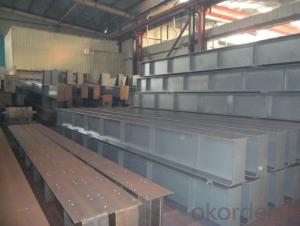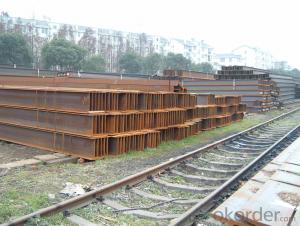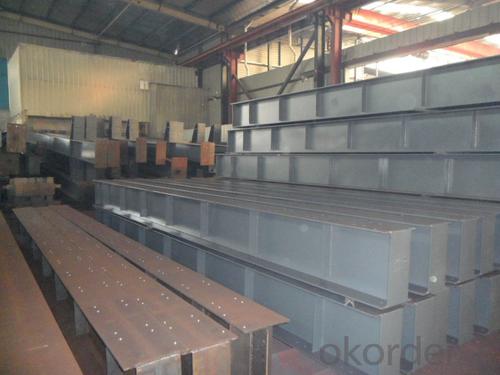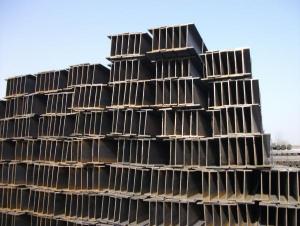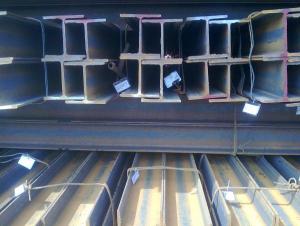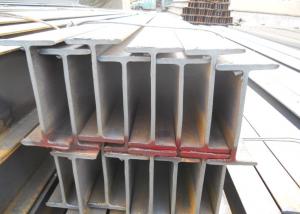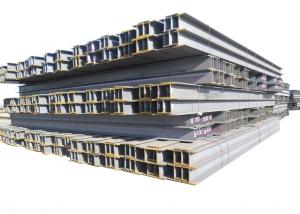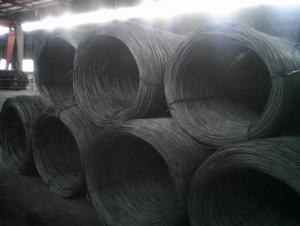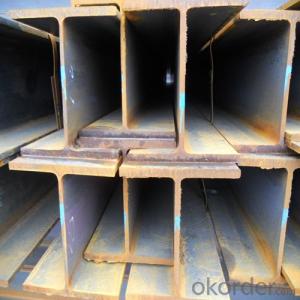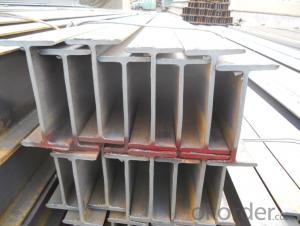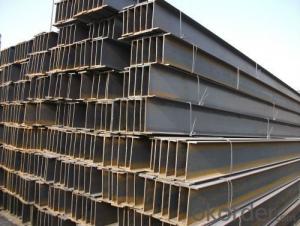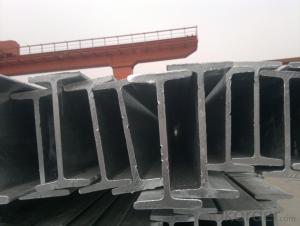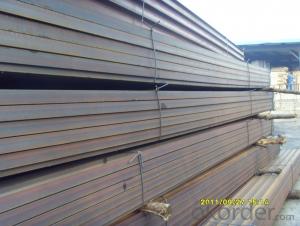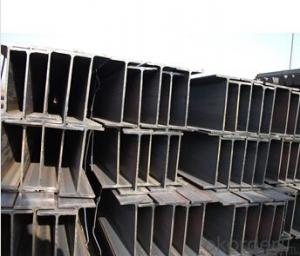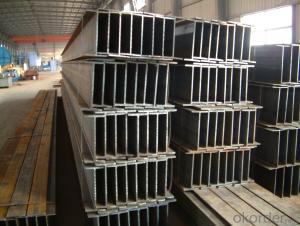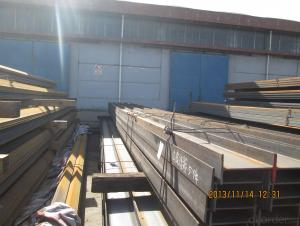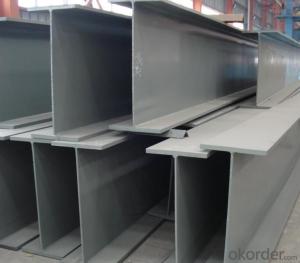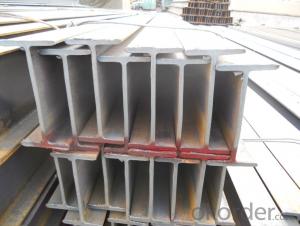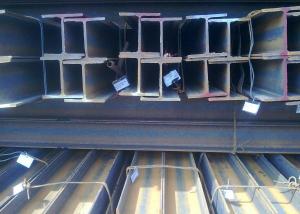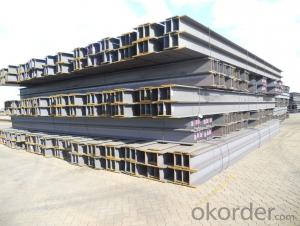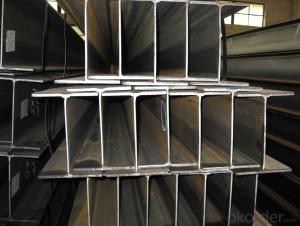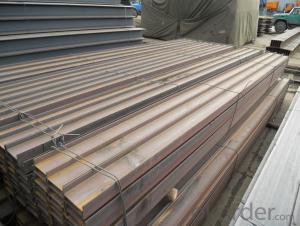Carbon steel H BEAM for construction GBQ235B
- Loading Port:
- Tianjin
- Payment Terms:
- TT or LC
- Min Order Qty:
- 25 m.t.
- Supply Capability:
- 100000 m.t./month
OKorder Service Pledge
OKorder Financial Service
You Might Also Like
Product Description:
OKorder is offering carbon steel H BEAM for construction GBQ235B at great prices with worldwide shipping. Our supplier is a world-class manufacturer of steel, with our products utilized the world over. OKorder annually supplies products to European, North American and Asian markets. We provide quotations within 24 hours of receiving an inquiry and guarantee competitive prices.
Product Applications:
Carbon steel H BEAM are ideal for structural applications and are widely used in the construction of buildings and bridges, and the manufacturing, petrochemical, and transportation industries.
Product Advantages:
OKorder's H BEAM are durable, strong, and resist corrosion.
Main Product Features:
· Premium quality
· Prompt delivery & seaworthy packing (30 days after receiving deposit)
· Corrosion resistance
· Can be recycled and reused
· Mill test certification
· Professional Service
· Competitive pricing
Product Specifications:
The wing plate, the web plate, the clamping and centering device, locating device and in the proves of spot welding are controlled automatically with PLC technology; the host drive is controlled by AC frequency converter, which ensures the stable and reliable operations; the upper fixing beam is equipped with four sets of rail assistant guide on both sides to ensure the stability when using the clamping device for a long period.
Technical Parameters:
Model | Specification of web plate | Specification of wing plate | Specification of wing plate | Power | Assembling Speed | ||
Thickness | Height | Thickness | Width | 400-15000mm | 11.7kw | 0.5-6m/min | |
Z15/ZLJ15 | 32mm | 200-1500mm | 40mm | 200-800mm | |||
Z18/ZLJ18 | 200-1800mm | ||||||
Z20/ZLJ20 | 200-2000mm | ||||||
FAQ:
Q1: How do we guarantee the quality of our products?
A1: We have established an advanced quality management system which conducts strict quality tests at every step, from raw materials to the final product. At the same time, we provide extensive follow-up service assurances as required.
Q2: What makes stainless steel stainless?
A2: Stainless steel must contain at least 10.5 % chromium. It is this element that reacts with the oxygen in the air to form a complex chrome-oxide surface layer that is invisible but strong enough to prevent further oxygen from "staining" (rusting) the surface. Higher levels of chromium and the addition of other alloying elements such as nickel and molybdenum enhance this surface layer and improve the corrosion resistance of the stainless material.
Images:
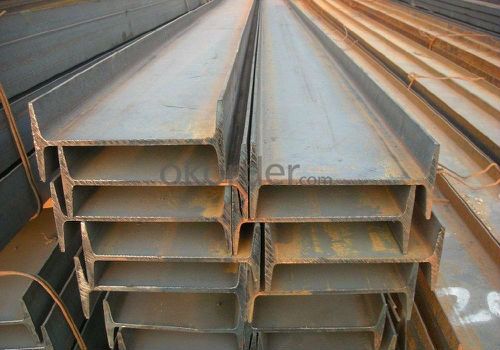
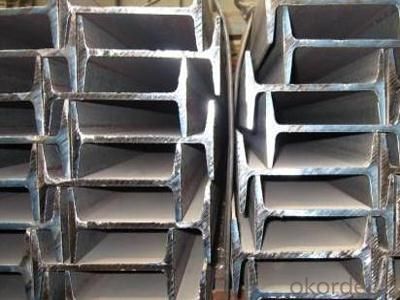
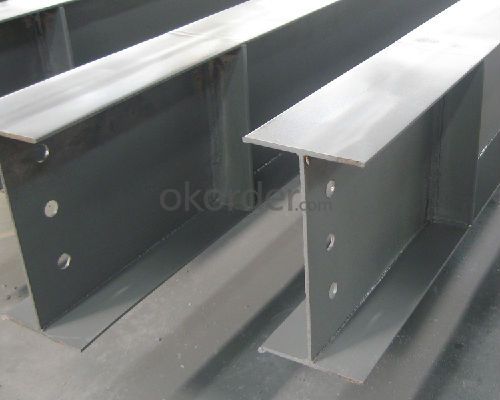
- Q: What is the weight per metre of 250x250x9x14h steel, please? Do you have any relevant information? Thank you
- H - B - height; width; T1 web thickness; T2 flange thickness; R radius of H type steel said method is as follows: height H width B * * * T1 web thickness plate thickness T2, such as H type steel Q235B:200 * 200 * 8 * 12 for high 200mm wide web thickness 200mm 8mm, wide flange H type steel plate thickness 12mm, the grade is Q235B
- Q: Can steel H-beams be used for convention centers?
- Indeed, convention centers can utilize steel H-beams. These beams are frequently employed in construction due to their robustness and capacity to bear heavy loads. Convention centers, being sizable structures, necessitate structural elements that can uphold substantial weights, including the weight of the roof, walls, and assorted equipment. Steel H-beams furnish the requisite structural integrity and resilience required to sustain the weight of these elements, thereby guaranteeing the safety and steadiness of the convention center. Furthermore, steel H-beams offer the adaptability to establish expansive open spaces without the need for excessive columns or supports, enabling the creation of versatile and customizable designs in convention center construction.
- Q: Can steel H-beams be used for religious buildings?
- Yes, steel H-beams can be used for religious buildings. Steel H-beams are widely used in construction due to their strength, durability, and versatility. They provide structural support and can be used for various applications, including religious buildings such as churches, mosques, temples, or synagogues. These beams can support the weight of the roof, walls, and other architectural elements, ensuring the stability and safety of the structure. Additionally, steel H-beams can be customized and fabricated to meet the unique design requirements of religious buildings, allowing for intricate designs and flexible layouts. Therefore, steel H-beams are a suitable choice for constructing religious buildings.
- Q: How are steel H-beams transported and handled on construction sites?
- Steel H-beams are typically transported and handled on construction sites using heavy machinery and equipment. The transportation process begins with loading the H-beams onto trucks or trailers, usually using cranes or forklifts. It is important to ensure that the H-beams are properly secured during transportation to prevent any damage or accidents. Once the steel H-beams arrive at the construction site, they are unloaded from the trucks or trailers, again using cranes or forklifts. The H-beams are then moved to the designated area where they will be used in the construction process. Handling steel H-beams requires careful planning and coordination. The beams are often quite heavy and bulky, so it is crucial to have the necessary equipment and machinery to lift and maneuver them safely. Cranes are commonly used to lift the H-beams and position them into place. These cranes are often operated by trained professionals who have expertise in handling heavy loads. In some cases, steel H-beams may need to be cut or modified on site to fit specific requirements. This is typically done using specialized cutting and welding equipment. It is important to follow proper safety procedures and guidelines when performing these tasks to ensure the integrity of the H-beams and the safety of the workers. Overall, transporting and handling steel H-beams on construction sites requires careful planning, coordination, and the use of appropriate machinery and equipment. Safety should always be the top priority to prevent accidents and ensure the successful completion of the construction project.
- Q: How do steel H-beams contribute to the overall flexibility and adaptability of a structure?
- The overall flexibility and adaptability of a structure are enhanced by the presence of steel H-beams in various ways. To begin with, H-beams possess immense strength and durability, enabling them to bear heavy loads and endure diverse environmental conditions. This strength empowers architects and engineers to conceive structures with larger spans and fewer support columns, resulting in more spacious and flexible areas. Furthermore, H-beams can be easily manipulated and cut into different lengths, allowing for a wide array of design possibilities. This versatility in size and shape renders them suitable for a multitude of structures, ranging from residential buildings to industrial warehouses and bridges. In addition, H-beams can be effortlessly joined together through welding or bolting techniques, facilitating the construction of intricate structures with varying levels and angles. This adaptability empowers architects and engineers to fashion distinct designs that meet specific requirements and aesthetic preferences. Moreover, steel H-beams exhibit excellent resistance to fire, corrosion, and pests, thereby ensuring the longevity and dependability of a structure. This reliability is essential for structures that need to withstand changing environmental conditions and potential hazards. Overall, steel H-beams assume a critical role in enhancing the flexibility and adaptability of a structure by providing strength, durability, and versatility in design. They permit larger spans, fewer support columns, and unique architectural designs, making them the preferred choice in modern construction.
- Q: What does "welding H" steel set "vertical" and "corrective processing" mean?
- According to the need of the project, can buy coil, coil length can be determined according to needs, here, flat, 12 meters long can be under the requirements of course, can also set foot flat, if you buy the flat plate is 9 meters *2 meters, is the longest length of only 9 meters, making H steel 12 meters long, feeding after docking, if the butt, butt joints need to stagger.
- Q: How do steel H-beams perform in vibration-prone environments?
- Steel H-beams are known for their excellent performance in vibration-prone environments. The unique design of H-beams, with their wide flanges and vertical web, provides superior rigidity and strength, making them highly resistant to vibrations. This structural shape helps to distribute the load evenly, minimizing the effects of vibrations on the beam. By using steel as the material for H-beams, they offer exceptional durability and stability, which is crucial in environments where vibrations are common. Steel has a high modulus of elasticity, meaning it can withstand and absorb vibrations without undergoing significant deformation or damage. This property makes steel H-beams a reliable choice for structures exposed to dynamic loads, such as bridges, high-rise buildings, and industrial facilities. Furthermore, steel H-beams can be fabricated with additional measures to enhance their performance in vibration-prone environments. These measures include using thicker flanges, increasing the beam's depth, or incorporating damping materials. By taking these steps, the H-beams can further dampen vibrations and reduce their effect on the overall structure. In conclusion, steel H-beams are well-suited for vibration-prone environments due to their inherent strength, rigidity, and durability. Their unique design and properties enable them to withstand vibrations without compromising the structure's stability. When properly designed and executed, steel H-beams provide a reliable and efficient solution for structures that need to perform well in such challenging conditions.
- Q: Are there any limitations or restrictions on the use of steel H-beams?
- Yes, there are certain limitations and restrictions on the use of steel H-beams. Some of the key considerations include: 1. Load-bearing capacity: Steel H-beams have specific load-bearing capacities based on their size, shape, and material grade. It is crucial to ensure that the selected H-beam can withstand the anticipated loads and stresses in a given application. Exceeding the load-bearing capacity can lead to structural failure. 2. Span length: The span length, or the distance between supports, is an important factor to consider when using steel H-beams. Longer spans may require larger and stronger beams to ensure structural integrity. Consulting structural engineers or relevant building codes can help determine the appropriate span length for a given application. 3. Structural design: Steel H-beams should be used according to proper design guidelines and engineering principles. It is essential to follow structural design codes and regulations to ensure safety and compliance. 4. Environmental conditions: Steel H-beams can be susceptible to corrosion, especially in harsh environmental conditions. In such cases, additional protective measures like coatings or galvanization may be necessary to enhance their durability. 5. Welding and fabrication: Steel H-beams often require welding or fabrication during installation. It is crucial to follow proper welding procedures and techniques to maintain the structural integrity of the beams. Improper welding or fabrication can weaken the beams and compromise their load-bearing capacity. 6. Fire resistance: Steel H-beams are generally not fire-resistant. In fire-prone environments, additional fireproofing measures like fire-resistant coatings or insulation may be required to protect the beams and maintain their structural stability during a fire. 7. Code compliance: Local building codes and regulations may impose specific limitations or restrictions on the use of steel H-beams. It is important to be aware of and adhere to these codes to ensure compliance and safety. It is recommended to consult with a structural engineer or relevant professionals to assess the specific limitations and restrictions that may apply in a particular use case.
- Q: How do Steel H-Beams contribute to the overall fire safety of a building?
- Steel H-Beams contribute to the overall fire safety of a building in multiple ways. Firstly, their high strength and load-bearing capacity make them effective structural elements that can withstand the impact of a fire, reducing the risk of building collapse. Additionally, steel has a high melting point, which means it can retain its structural integrity for a longer period during a fire compared to other materials like wood or concrete. This allows occupants more time to evacuate safely. Moreover, steel H-Beams have a low combustibility, meaning they do not contribute to the spread of fire. Overall, these features make steel H-Beams an essential component in enhancing the fire safety of a building.
- Q: Can steel H-beams be used for sports arenas or stadiums?
- Indeed, sports arenas or stadiums can utilize steel H-beams. These beams are frequently employed in the construction sector owing to their robustness and adaptability. They furnish exceptional structural support, rendering them appropriate for extensive undertakings such as sports arenas or stadiums. The beam's H shape permits an augmented load-bearing capacity, making it an optimal choice for enduring the weight of a stadium's roof, seating sections, and other infrastructure. Moreover, steel H-beams are renowned for their endurance and resilience against environmental elements like weather and seismic activity, which establishes them as a dependable selection for enduring sports facilities.
Send your message to us
Carbon steel H BEAM for construction GBQ235B
- Loading Port:
- Tianjin
- Payment Terms:
- TT or LC
- Min Order Qty:
- 25 m.t.
- Supply Capability:
- 100000 m.t./month
OKorder Service Pledge
OKorder Financial Service
Similar products
Hot products
Hot Searches
Related keywords
